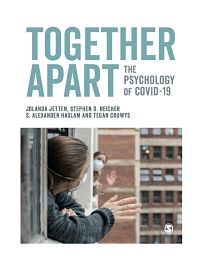Common Identity, Humanity, and COVID-19: Excerpt from ‘Together Apart’
“Wearing a mask is a sign of respect.”
New York Governor Andrew Cuomo, May 12th 2020
In the first chapter of this book, we discussed the importance of groups with a quote from Andrew Cuomo: “It’s not about me it’s about we. Get your head around the we concept.” Now, in this final chapter, we start with another quotation from the New York Governor illustrating why the ‘we concept’ (what we would call social identity) is so important.
Responding to COVID-19 is about harnessing the positive side of group psychology
If you make wearing masks a sign of concern for others in the group (a ‘we’ thing), it becomes a symbol of mutual care and brings people together. However, if you make it about individual beliefs and preferences (an ‘I’ thing), the mask becomes a symbol of division and a site of conflict. That has been happening across the U.S., as those who insist on their right to wear masks clash with those who insist on their right not to wear masks (Noor, 2020). It is what led Cuomo to make his remarks. It is also what led another Governor — the Republican Governor of North Dakota, Doug Burgum — to implore citizens not to make masks “a senseless dividing line” between people. He continued: “We’re all in this together and there’s only one battle we’re fighting, and that’s the battle of the virus” (cited by Pengelly, 2020).
But this issue of mask wearing is not simply a matter of ‘we’ good, ‘I’ bad. It is also an issue of how we define the ‘we’ — or to put it more formally, an issue of how we define the groups to which we belong. Instead of the ‘we’ referencing all citizens, it can become a matter of ‘freedom-loving Conservatives’ versus ‘public health-concerned Liberals’, in which case there is no unity and consensus. Rather, all that one has achieved is collectivized division, rooted in a set of entrenched differences, and hence made more bitter and intractable.

This encapsulates a tension that has run throughout this book. How can we harness the positives of group psychology — solidarity, social support, psychological resilience — without invoking the negatives — division, hatred, conflict? We will start by summarizing what has been learnt thus far about these issues before offering a way forward based on what we know about the creation of common identity.
Three lessons emerge from research on intergroup relations
Whatever else people might differ on, few would disagree that we face a life and death struggle against COVID-19. In the first paragraph of Chapter 1, the figures quoted were some 4 million infections and a quarter of a million deaths. That was when the writing started. In the few weeks during which this book has been written, the figure of infections has risen by one and a half million, the figure of deaths by one hundred thousand. Whoever we are and wherever we are, COVID-19 represents an existential threat to us all.
If there one thing that psychologists agree on, even if they sometimes differ on why, it is that threats from outside the group strengthen the salience of social identity (Chapter 7). Within the group, increased social identity salience leads to increased social support, solidarity and adherence to group norms. As we saw in Chapter 11, threatened groups that were already highly cohesive become even more cohesive and, even where there was no previous sense of community, it can often emerge as, “together, we face up to a common threat”. Such loyalty, altruism, community organisation and conformity are crucial in helping us to surmount the psychological and practical problems of a dangerous and uncertain world (Hogg et al., 2017; Kunst et al., 2019). This is group psychology at its best.
Lesson 2: Threat consolidates group boundaries and so increases exclusion between groups
A fundamental premise of the social identity approach is that you cannot have an ‘us’ without a ‘them’ — for (as we outlined in Chapter 2) how can we have a sense of who we are without contrasting it to those we are not? So, if one strengthens group boundaries, one increases the exclusion of outgroup members as surely as one increases the inclusion of ingroup members.
Nevertheless, this does not necessarily mean that one is always negative towards the outgroup (Jetten et al., 2004). For example, scientists may not be poets but that does not mean that they hate, or are in conflict with poets. But it does mean that scientists are less likely to offer poets the positives (e.g., solidarity and cooperation) which they extend to fellow ingroup members (Reicher et al., 2008).
However, if we see others as a part of the threat to us — especially when it is an existential threat — then the withdrawal of kindness to outgroups can quickly escalate to active cruelty (Reicher et al., 2008; Stephan & Stephan, 2000). When Jewish people were defined as the source of the plague, where Muslims are seen as the source of COVID-19 in India or Asian-Americans were blamed in the U.S., then ‘their’ destruction can be justified in the name of ‘our’ preservation (see Chapter 19). This is group psychology at its worst.
Lesson 3: Whether we see the best of the worst of group psychology depends upon how inclusively or exclusively we define our ingroups and outgroups
If group threat leads both to solidarity within the group and to exclusion — or even conflict — between groups, then whether we see the best or the worst of group psychology turns on the question of how broadly or narrowly the ingroup is defined. That, in turn, is dependent on how the threat is defined.
If threat is seen to stem from groups within the nation, then national unity will be impossible to achieve and domestic conflict will prevail instead. This could be because a particular national minority is accused of being responsible for the disease (as with the notion of ‘Corona-jihadism’ in India which puts blame on Muslims). However, it could also be because the threat is understood to be not the virus itself or but rather the response to the virus — and that is blamed on political opponents (as in President Trump’s call to ‘liberate’ states from lockdown by Democratic Governors).
If threat is seen to stem from other nations, then international unity will be impossible to achieve and it will be much harder to overcome the pandemic. As Salisbury and Patel (2020) argue: “responding to Coronavirus needs clarity of global leadership that arches over national interests and is capable of mobilizing resources at a time when economies are facing painful recessions”.
If, however, the threat is defined as the virus itself, and as pitting a non-human source against all of humanity, then there is the possibility of developing what Tajfel and Turner (1979) called the ‘superordinate level of categorization’. That is, instead of dividing people into different social categories, humanity as a whole can be constituted as a single category (see also Chapter 7). If that happens, then anyone’s suffering becomes my own and we have the prospect of harnessing the best without risking the worst of group psychology.
Overcoming COVID-19 depends on developing a sense of common identity
The crux of our argument is that the best way of harnessing intra-group solidarity without incurring inter-group conflict is to create the broadest and most inclusive ingroups. This idea aligns very much with Gaertner and Dovidio’s common ingroup identity model. A central premise of this model is that intergroup hostility can be reduced if group members recategorize those who would otherwise be seen as outgroup members as ingroup members within an inclusive superordinate category (Gaertner et al., 2016). This can happen, for example, when people who are seen as outgroups on the basis of race or ethnicity are re-categorized in terms of a shared national identity.
Moreover, research within the common ingroup identity perspective confirms and extends many of the other core points made in this book. When members of previously divided groups come to see themselves as members of a common superordinate category, then erstwhile foes can become fellows. We feel closer to those we once excluded, experience greater empathy for them, engage in greater self-disclosure, and are more accepting and charitable (Dovidio & Banfield, 2015; Dovidio & Gaertner, 2010; Levine & Thompson, 2004). For example, increasing the salience of Jewish students’ “human identity,” in contrast to their “Jewish identity,” has been found to enhance their perceptions of similarity between Jews and Germans, as well as their willingness to work constructively with German students (Wohl & Branscombe, 2005).
The critical question, of course, is how this sense of common ingroup identity can be achieved. This again is a question we have discussed throughout the book, and again the common ingroup identity model provides answers that both confirm and extend previous arguments. On the one hand, it is possible to draw on historically established superordinate memberships (e.g., as members of the same local community, organization, nation or indeed as global citizens confronting shared global challenges such as climate change and the fires, floods and droughts it brings across the globe). On the other hand, it is possible to create new inclusive identities forged by common fate or by interdependence in the face of a shared loss or a mutual enemy.
What is more, as argued in Chapter 3, the role of leadership is critical. Whether it be a matter of invoking the relevance of pre-existing categories or of highlighting our interdependence in a dangerous world, leaders mediate between the nature of the world we live in and our understanding of who we are within it. Consider, for instance, the words of European Council President, Charles Michel (cited in Barry, 2020): “This pandemic is putting our societies under serious strain. The well-being of each E.U. member state depends on the well-being of the whole of the E.U.. We are all in this together”. His argument centres on the economic interdependence of the individual member states in the E.U.: one fails, all are in danger. This was a logic picked up by the President of the European Monetary Fund, Ursula von der Leyen when she presented common European identity as the key mechanism through which Europe could overcome early setbacks in responding to the pandemic — setbacks associated with the fact that “When Europe really needed an ‘all for one’ spirit, too many initially gave an ‘only for me’ response” (Wheaton & de la Baume, 2020).
Effective responses to COVID-19 require forging an “all for one” spirit
Our only qualification to von der Leyens’ words is that they do not just apply to Europe. The toll from COVID-19 is too high already, aided and abetted by an ‘only for me’ (or, rather, ‘only for my narrow ingroup’) spirit. How much further it will rise is highly dependent on our ability to forge an ‘all for one” spirit, rooted in the creation of a fully inclusive common group identity.
Explore the section of Together Apart on intergroup relations
Prejudice and Discrimination| Yuen J. Huo
Inequality | Jolanda Jetten
Common Identity and Humanity | John F. Dovidio, Elif G. Ikizer, Jonas R. Kunst, & Aharon Levy
Societal Polarization | Charlie R. Crimston & Hema Preya Selvanathan































































































